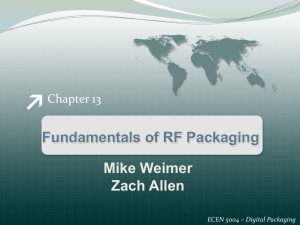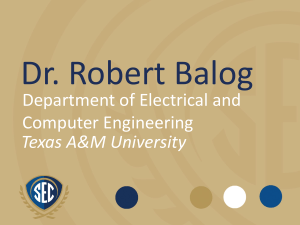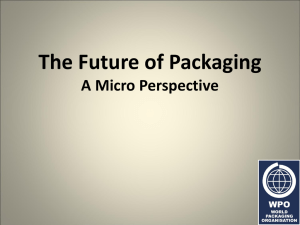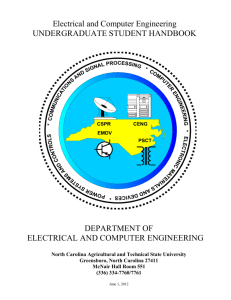Chapter 4
advertisement
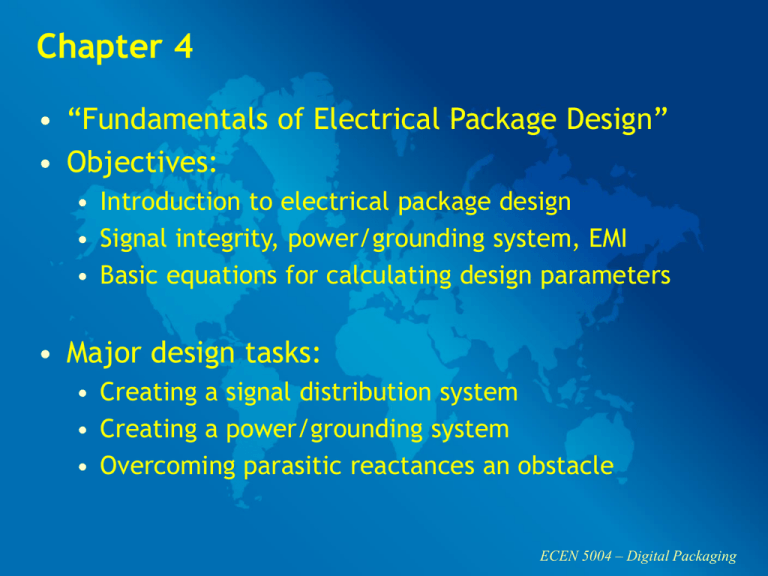
Chapter 4 • “Fundamentals of Electrical Package Design” • Objectives: • Introduction to electrical package design • Signal integrity, power/grounding system, EMI • Basic equations for calculating design parameters • Major design tasks: • Creating a signal distribution system • Creating a power/grounding system • Overcoming parasitic reactances an obstacle ECEN 5004 – Digital Packaging 4.1 What is Electrical Package Design? • Electrical signal and power path design • Functions: • • • • • Provide signal/power distribution Protection from environment (chemical/ physical) Thermal mitigation Connectivity within package, between layers Potential for lumped passive elements ECEN 5004 – Digital Packaging 4.1 What is Electrical Package Design? ECEN 5004 – Digital Packaging 4.2 Fundamentals of Electrical Design • Ohm’s Law • Minimize resistances to minimize thermal losses • Skin Effect • AC resistances are higher than DC, particularly at elevated frequencies where current concentration is highest at the surface • Capacitances and Inductances act as storage elements • Kirchhoff’s Laws (KVL/KCL) • Voltages around a loop sum to zero • Currents into a node sum to zero • Useful for calculating voltages and currents throughout the packaged circuit ECEN 5004 – Digital Packaging 4.2 Fundamentals of Electrical Design • Noise • • • • Undesired signals affect circuit operation Minimize unwanted internal/external interference Parasitic capacitances/inductances are problematic Minimize copper-conductor lengths to reduce parasitics • Time Delay • Resistance + capacitance or inductance = delay (T=RC, T=L/R) • RC delay limits overall speed of the packaged system • Contributes to simultaneous switching noise (ssn) • Simultaneous Switching Noise (ssn) • Fluctuation in signals resulting from transient variation in supply voltages • Caused by the limited ability of the supply to quickly respond • Use decoupling capacitors to provide instantaneous energy ECEN 5004 – Digital Packaging 4.2 Fundamentals of Electrical Design • Transmission Lines • Electricity carried by EM waves • Finite signal propagation due to material properties (condensed matter physics) • Proper ‘matching’ required for no reflections • Crosstalk • Results from capacitive/inductive coupling • Transmission line modeling to mitigate effects • EMI • Time-varying signals and external noise • Switching power supplies • Proper grounding ECEN 5004 – Digital Packaging 4.2 Fundamentals of Electrical Design • SPICE Modeling • Usually a nightmare for complex circuits • • • Dreaded ‘floating node’ and ‘infinite current loop’ errors Limited to 64 nodes in pSPICE version 9.2 Otherwise useful for general analysis ECEN 5004 – Digital Packaging 4.3 Electrical Anatomy of Packaging • Dealing with parasitic elements • They’re everywhere you don’t want them to be • Cause delay, skew, lead/lag, and transient power fluctuations • Transmitted signal winds up being degraded • Primary challenge: • Handling non-ideal effects • Package design must meet specifications ECEN 5004 – Digital Packaging 4.3 Electrical Anatomy of Packaging ECEN 5004 – Digital Packaging 4.4 Signal Distribution • Devices and Interconnections • MOSFETs are most frequent devices • Operated as a switch (cutoff / saturation modes) • Binary state at the gate determines mode * Diagrams conveniently stolen from Wikipedia ECEN 5004 – Digital Packaging 4.4 Signal Distribution • Non-idealities in MOSFETs • On-resistance RON • • • Leads to non-zero voltage drop Thermal losses Potential for other parasitic problems and delays • Switching delay, rise/fall times • • Limit speed of packaged circuit Consume energy to charge/discharge gate capacitance • Capacitive Delay of Interconnections ECEN 5004 – Digital Packaging 4.4 Signal Distribution • Kirchhoff’s Laws and Transit Time Delay • • • • Propagation at C (3 x 108 m/s) in air Propagation at <C in solids KVL/KCL fail to account for delays or phase shift Time domain analysis • Time of Flight • Frequency domain analysis • • • Main parameter is wavelength λ = c/f speed in material = (3 x 108)/(εrμr)1/2 [m/s] ECEN 5004 – Digital Packaging 4.4 Signal Distribution • Transmission Line Behavior of Interconnections • LΔz is total series inductance of equivalent circuit • RΔz is total series resistance of equivalent circuit • Application of Kirchoff results in Figure 4.9 • See ‘Telegrapher’s Equations’ for further information ECEN 5004 – Digital Packaging 4.4 Signal Distribution • Waves Between Digital Gates • Parallel strip is common, easy to design • Microstrip, embedded microstrip, and stripline • • • Microstrip: between air and dielectric E-Microstrip: embedded within a dielectric Stripline: connection between two metal layers ECEN 5004 – Digital Packaging 4.4 Signal Distribution • Signals exhibit a finite velocity • • • • Output from line is not instantaneous vp = 1/(LC)1/2 Input appears to be a resistance (top figure) Load terminated by MOSFET (high resistance) Equivalent circuit at (a) generator and (b) load ECEN 5004 – Digital Packaging 4.4 Signal Distribution • Match the Terminations and Line Impedances • Basic Electromagnetics • Unmatched terminations lead to reflections • How to match previous figure: (a) Matching by adding 45 ohm series resistance, and (b) Resulting system with matched impedances. ECEN 5004 – Digital Packaging 4.5 Power Distribution • Interconnects must also carry power • Active elements require power to operation • Voltage drop and inductive effects are main issues • Supply voltage may not be the same everywhere due to V=IR drops throughout the package • Parasitic inductance leads to voltage drops: • • • Vsupply = (L1+L2)(di/dt)+R*i(t) Vload(t) = Vsupply(1-e-t/T)u(t) The load voltage is therefore the supply voltage plus the induced time constant parameter ECEN 5004 – Digital Packaging 4.5 Power Distribution • Effective power distribution inductances • Inductances L1 and L2 are for voltage and ground leads for the package Power distribution inductance Inductive effect ECEN 5004 – Digital Packaging 4.5 Power Distribution • Effective Inductance • Used to evaluate the power distribution performance of the package • Contribution can be either additive or subtractive Additive: currents are in same direction • Subtractive: currents are in opposite directions • Assuming a mutual inductance M between inductors: Vsupply = (L1+L2-2M)(di/dt)+Ri(t) Time Constant: T = (L1+L2-2M)/R Effective Inductance: Leff = L1+L2+M (reduced due to mutual inductance between voltage and ground leads of the package) • ECEN 5004 – Digital Packaging 4.5 Power Distribution • Power Supply Noise • Local, real supplies source finite current • With series inductances, the local Vdd will drop since the inductor current cannot change instantaneously • • • Result: transient fluctuations in supply voltage ΔV = Leff(dI/dt) Called simultaneous switching noise (ssn) • Effect of Packaging on Inductance • Minimizing inductance reduces supply noise • Effective inductance varies from package to package (quad flat pack, QFP, or ball grid arrays, BGAs, etc.) • Inductance is either due to spheres or planes ECEN 5004 – Digital Packaging 4.5 Power Distribution • Inductance and Noise Relationships • With series inductances, the local Vdd will drop since the inductor current cannot change instantaneously • • • Result: transient fluctuations in supply voltage ΔV = Leff(dI/dt) Called simultaneous switching noise (ssn) • Effect of Packaging on Inductance • Minimizing inductance reduces supply noise • Effective inductance varies from package to package (quad flat pack, QFP, or ball grid arrays, BGAs, etc.) • Inductance is either due to spheres or planes ECEN 5004 – Digital Packaging
